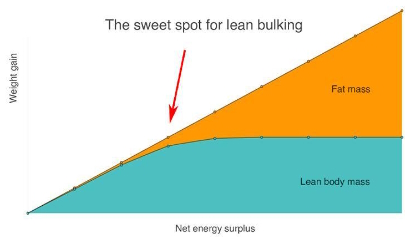A frequently asked question from natural bodybuilders is whether you can build pure muscle mass without also gaining fat mass. The answer: usually this is not possible, unless you can apply body recomposition.
ENHANCED VERSUS NATURALS
It is the ultimate wish of many bodybuilders: to grow rock-hard muscle mass without fat mass. This is doable for bodybuilders who use steroids. However, it is almost impossible for naturals in the bulk who use a calorie surplus: in addition to new muscle mass, they will always have to tolerate some new fat mass.
LEAN BULKING
To build muscle with as little fat mass as possible, you do a so-called lean bulk. That means you only consume a little extra calories.
With a lean bulk you eat 10-20% of your maintenance level extra. That means a surplus that amounts to 250-500 kcal. As a beginner you can possibly sit a little higher. At that 10-20% you will ‘gain’ 0.5 to 1 gram per kilogram of your body weight every week. So a small amount and even then that is not pure muscle mass. Most coaches use as a rule of thumb: 60% muscle mass and 40% fat mass.
Practice shows that significant muscle building is rarely accompanied by an increase in fat mass. This is partly due to the fact that you can never track your calorie surplus perfectly accurately. Sometimes you may be eating a few hundred calories more than your bulk surplus without realizing it.
It’s up to you to find out what the perfect calorie surplus is for you. Start low, around 10%, then ramp up when you think there’s more muscle mass in the barrel. If you become fat, your surplus is too high. Our advice is to aim for the sweet spot (see image below) for bulking. Here you build almost maximum muscle, while only a little bit of fat is added. You can get rid of that fat later during a (mini) cut. So don’t be afraid of a little fat in bulk.
For a successful lean bulk you will have to keep track of your food intake quite accurately. There are mobile apps for that. But even with such an app you will never be able to accurately measure your calories and macronutrients. Sometimes you eat more than the app indicates and those calories are then inexorably stored as fat.
BODY RECOMPOSITION
Is building muscle without increasing fat mass completely impossible? No. In fact, it is even possible to build muscle and lose fat at the same time. However, you should not bulk then, but operate in a different mode: that of body recomposition.
With body recomposition you benefit from the fact that your body can extract energy for muscle growth from existing fat reserves. In addition, the growth stimulus from training can be so great that less ‘back-up’ from food is needed. This mainly applies to novice strength athletes. You can read here and here how body recomposition works exactly.
The big disadvantage of body recomposition is that muscle mass gain is very slow when you are more advanced. At a certain point, the increase in muscle mass stops completely. ‘Recompen’ is therefore only worthwhile if you are a beginner and/or have a lot of fat mass. For advanced users, bulking and cutting is much more efficient, especially if you have trouble gaining muscle mass.
CONCLUSION
Practice shows that bulking without (a small) increase in fat mass is more or less impossible. But that’s not a bad thing either: lean bulking, with a calorie surplus of no more than 10-20% of your maintenance level, allows you to optimally build muscle without too much fat mass. You can later make the fat disappear in the cut.
To find your bulking sweet spot, start low, with a 10% surplus. If you think there is more muscle mass in the barrel and you have not gained much fat, try 15 or 20%. Your scale is your best friend.
Instead of bulking, some gymgoers do body recomposition. This is building muscle and losing fat at the same time. Unfortunately, this is only realistic for novice strength athletes and/or overweight people.
